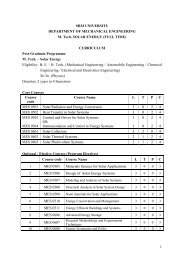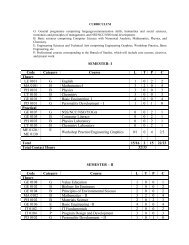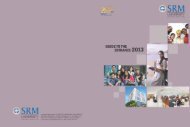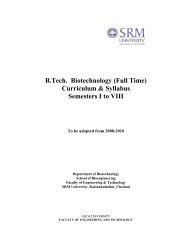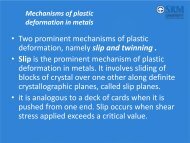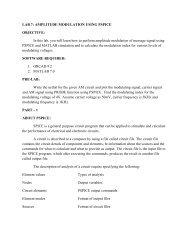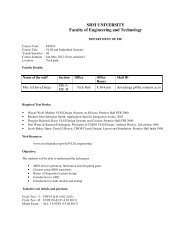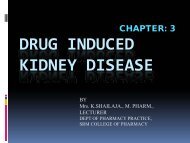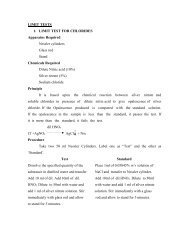CHAPTER 1 COMMUNITY PHARMACY - SRM University
CHAPTER 1 COMMUNITY PHARMACY - SRM University
CHAPTER 1 COMMUNITY PHARMACY - SRM University
You also want an ePaper? Increase the reach of your titles
YUMPU automatically turns print PDFs into web optimized ePapers that Google loves.
<strong>CHAPTER</strong> 1<br />
<strong>COMMUNITY</strong> <strong>PHARMACY</strong><br />
M.ASHOKKUMAR<br />
DEPT OF <strong>PHARMACY</strong> PRACTICE<br />
<strong>SRM</strong> COLLEGE OF <strong>PHARMACY</strong><br />
<strong>SRM</strong> UNIVERSITY
<strong>COMMUNITY</strong> <strong>PHARMACY</strong><br />
OPERATIONS<br />
• Technician Duties Related to Dispensing<br />
Over-the-Counter Drugs and Diet<br />
Supplements: In the community pharmacy, a<br />
pharmacy technician assumes a number of<br />
responsibilities related to both OTC and legend<br />
drugs, which depend on state laws and regulations.
<strong>COMMUNITY</strong> <strong>PHARMACY</strong><br />
OPERATIONS<br />
• Technician Duties Related to Dispensing<br />
Prescription Drugs: A technician can take<br />
written prescriptions from walk-in customers but<br />
cannot take new prescriptions by telephone and<br />
reduce them to writing.
Figure 6.5
Community Pharmacy<br />
Safety Note!<br />
Dispensing Issues<br />
• Pharmacy technicians should not counsel patients<br />
about OTC products without the approval of the<br />
pharmacist.
GUIDELINES FOR RECEIVING AND<br />
REVIEWING PRESCRIPTIONS<br />
• Checking for Patient Allergies: The parts<br />
of a prescription include prescriber information,<br />
the date, patient information, the symbol Rx, the<br />
inscription, the subscription, the signa, additional<br />
instructions, and the signature.
GUIDELINES FOR RECEIVING<br />
AND REVIEWING<br />
PRESCRIPTIONS<br />
• Receiving a Controlled-Drug<br />
Prescription: Prescriptions for controlled<br />
substances require special record-keeping<br />
procedures. Pharmacy technicians should be sure<br />
to follow any labeling requirements as determined<br />
under state and federal law.
Critical Path of a<br />
Prescription<br />
1. The patient drops off the prescription.<br />
Table 6.1
Table 6.1<br />
Critical Path of a<br />
Prescription<br />
2. The pharmacy technician checks the<br />
prescription to make certain it is complete<br />
and authentic; then he or she verifies that<br />
the patient is in the pharmacy database. If<br />
the patient is not in the pharmacy database,<br />
the technician obtains necessary<br />
demographic, insurance, and allergy<br />
information from the patient and enters the<br />
information into the computer.
Critical Path of a<br />
Prescription<br />
3. The pharmacy technician enters the<br />
prescription into the computer, bills the<br />
insurance company or the patient, and<br />
generates the medication label.<br />
Table 6.1
Critical Path of a<br />
Prescription<br />
4. The pharmacy technician asks the<br />
pharmacist to check the drug use review<br />
(DUR) or drug interaction warning screen<br />
when required.<br />
Table 6.1
Critical Path of a<br />
Prescription<br />
5. The pharmacy technician selects the<br />
appropriate medication and verifies the<br />
National Drug Code (NDC) number on the<br />
computer-generated medication label.<br />
Table 6.1
Critical Path of a<br />
Prescription<br />
6. The pharmacy technician prepares the<br />
medication(s) (e.g., the prescribed number<br />
of tablets is counted or the liquid<br />
measured).<br />
Table 6.1
Critical Path of a<br />
Prescription<br />
7. The pharmacy technician packages the<br />
medication in the appropriate container.<br />
Table 6.1
Critical Path of a<br />
Prescription<br />
8. The pharmacy technician labels the<br />
prescription container with the computergenerated<br />
medication label. In some states<br />
the law requires the pharmacist to affix the<br />
label to the container.<br />
Table 6.1
Critical Path of a<br />
Prescription<br />
9. The pharmacy technician prepares the<br />
filled prescription for the pharmacist to<br />
check.<br />
Table 6.1
Critical Path of a<br />
Prescription<br />
10. The pharmacist checks the<br />
prescription(s) and may initial it.<br />
Table 6.1
Critical Path of a<br />
Prescription<br />
11. The pharmacy technician bags the<br />
approved prescription for patient sale and<br />
attaches an information sheet about the<br />
prescription, including indications,<br />
interactions, and possible side effects.<br />
Table 6.1
Critical Path of a<br />
Prescription<br />
12. The pharmacy technician returns the<br />
bulk product container to the shelf.<br />
Table 6.1
Critical Path of a<br />
Prescription<br />
13. The pharmacy technician delivers the<br />
packaged prescription to the cash register<br />
area for patient pickup and pharmacist<br />
counseling.<br />
Table 6.1
Figure 6.1
Community Pharmacy<br />
Safety Note!<br />
Dispensing Issues<br />
• Show all questionably authentic prescriptions to<br />
the pharmacist.
Terms to Remember<br />
• signa<br />
• allergy<br />
• adverse drug reaction<br />
Learn more at American Institute of the History of Pharmacy (AIHP)
Discussion<br />
• Discuss how you would handle a<br />
prescription for a controlled substance that<br />
you suspect is forged.
PATIENT PROFILE<br />
• Creating New Profiles: The pharmacy<br />
technician is often responsible for entering the<br />
new prescription order and creating or updating<br />
the computerized patient profile.
Figure 6.2
Figure 6.3
Terms to Remember<br />
• patient profile<br />
Learn more at American Institute of the History of Pharmacy (AIHP)
MEDICATION SELECTION<br />
AND PREPARATION<br />
• Preparing Oral Dose Forms: Oral drug products are<br />
available in many different dose forms, and each dose<br />
form has its own dispensing requirements.
Figure 6.4
MEDICATION SELECTION<br />
AND PREPARATION<br />
• Dispensing Prepackaged Drugs: Filling a prescription<br />
often involves simply retrieving from stock a drug with<br />
the right name, manufacturer, and strength.
MEDICATION SELECTION<br />
AND PREPARATION<br />
• Dispensing Schedule V Over-the-Counter Drugs:<br />
Some Schedule V controlled substances may be<br />
dispensed without a prescription under specific<br />
conditions.
MEDICATION SELECTION<br />
AND PREPARATION<br />
• Dispensing Drugs That Contain Ephedra: Many<br />
states have passed legislation restricting the access and<br />
sale of products containing ephedra and<br />
pseudoephedrine.
MEDICATION SELECTION<br />
AND PREPARATION<br />
• Choosing Containers: A wide variety of amber vial<br />
sizes are available and selecting the proper vial size is a<br />
skill that will be learned quickly
Terms to Remember<br />
• unit of use<br />
Learn more at American Institute of the History of Pharmacy (AIHP)
Discussion<br />
• It can be frustrating for a customer have<br />
difficulty identifying the pharmacist and<br />
to not understand the different roles of<br />
the pharmacist and the pharmacy<br />
technician. What types of things could<br />
you do as a pharmacy technician to help<br />
the customers?
LABEL PREPARATION<br />
• Contents of a label: Medication container labels<br />
must contain many different elements, including a<br />
unique prescription number, the name of the<br />
patient, directions for use, and the name and<br />
strength of the medication.
Figure 6.6
Terms to Remember<br />
• package insert<br />
Learn more at American Institute of the History of Pharmacy (AIHP)
FINAL CHECK OF THE<br />
PRESCRIPTION<br />
• Final Checking: The pharmacist is responsible<br />
for the final check of the original prescription, the<br />
patient profile, the drug and drug quantity used,<br />
and the accuracy of the medication label.
Community Pharmacy<br />
Safety Note!<br />
Dispensing Issues<br />
• The technician should become aware and<br />
thoroughly familiar with the appropriate state’s<br />
regulations concerning scheduled drugs.




